RF Radiation & Cell Phones: New NTP Report
NYTimes vlog
WSJ vlog
[It is amusing to note that in the above pair of videos the left of center NYTimes is more defensive of the cellular industry than the right of center WSJ which seems to find this study to be a major turning point.]
Last week the National Toxicology Program released a report requested by FDA. The National Toxicology Program is an interagency program established in 1978 to coordinate toxicology research and testing across the Department of Health and Human Services. It is a partnership of 3 agencies:
- National Institute of Environmental Health Sciences (NIEHS)
- The U.S. Food and Drug Administration, primarily through its National Center for Toxicological Research (NCTR/FDA); and
- National Institute for Occupational Safety and Health of the Centers for Disease Control and Prevention
Here is summary of the report from Scientific American:
The researchers found that as the thousands of rats in the new study were exposed to greater intensities of RF radiation, more of them developed rare forms of brain and heart cancer that could not be easily explained away, exhibiting a direct dose–response relationship. Overall, the incidence of these rare tumors was still relatively low, which would be expected with rare tumors in general, but the incidence grew with greater levels of exposure to the radiation.
Let us also point out that actual RF exposures from non voice use of cell phones and voice use with the speaker in the handset is much less because of distance. Indeed, Bluetooth earpieces are increasingly common and that also decreases actual exposure. In 2010 there was the surprising news that voice use of cell phones was actually decreasing! We could not find recent data to confirm that but CTIA's 2015 Annual Survey Report shows the following related data:
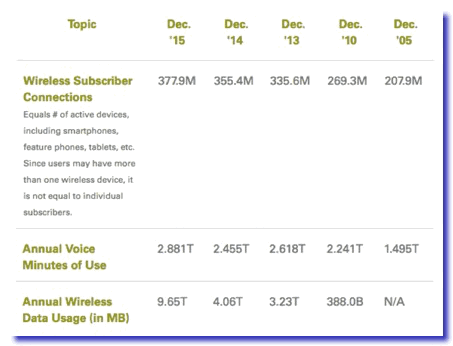
So while data use of cell phones is skyrocketing, in 10 years the total number of voice minutes has only increased 93% even as the number of devices has increased 82%. Voice minutes is not a dynamic growth industry! Considering likely increased use of Bluetooth, then human exposure to RF fields from cell phones is probably decreasing on the average as data use, further from the body, predominates. Of course, just because average exposure is stable or decreasing, some people may have high exposures under current regulations.
For many years the cellular industry has been hiding behind legally correct statements that their products meet at federal regulations when used properly. For example in 2010 CTIA stated, "In fact, all phones sold legally in the U.S. must comply with the Federal Communications Commission’s safety standards for RF emissions. According to the FCC, all such compliant phones are safe phones as measured by these standards."
Legal sources in the cellular industry have told me that if there is ever evidence that their products cause a pathological health effect of any kind then this time of continuing statement can be used as a defense to avoid or minimize liability. Thus it is logical for the industry to deny any risk and hide behind federal standards and say that nothing else is need. Thus the industry tried mightily to block Chmn. Kennard when he decided around 2000 that the SAR ratings of various cellphone models should readily accessible to the public. The information was already in public files on the voluminous FCC website but very difficult to find. Senior FCC staffers friending to the industry argued to Chmn. Kennard that that making the data public would require a large investment in software changes to the website that was not affordable. These industry friendly senior staffers were not pleased when I spent a day at the FCC Lab and discovered a way to make the information much more readily available without any new software and with negligible increase in staff processing time.
The text 0f this is unlike any statement on either the FCC or CTIA website as it shows how one might decrease one's exposure to RF fields to minimize risk. Note that similar information for decreasing exposure can be found on the website of the Swiss Federal Office of Public Health (FOPH).
The FCC's Canadian counterpart, formerly Industry Canada but recently renamed, Innovation, Science and Economic Development Canada has this information on its website:
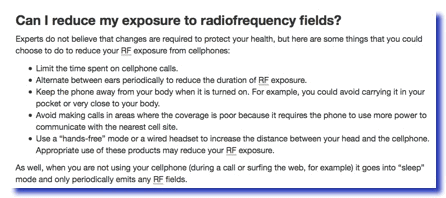
Resources
Recording of NTP briefing on report release
Full report
Scientific American article on report
Science magazine
(Statements of the cellular industry will be added when they are available)
UPDATE
After several tweets from me observing the continuing silence of both FCC and CTIA on the NTP report, at 4:43 PM on June 13th I received from CTIA Media Relations:
Please attribute to a CTIA spokesperson:
"Americans' health is paramount to CTIA and the wireless industry. Since we are not scientific researchers, we follow the guidance of the experts when it comes to cellphones and health effects. According to the U.S. Food and Drug Administration (FDA), World Health Organization (WHO), American Cancer Society and numerous other international and U.S. organizations and health experts, the scientific evidence shows no known health risk due to the RF energy emitted by cellphones. As the FDA states on its website, '[t]he weight of scientific evidence has not linked cellphones with any health problems.'
"The FCC has determined that all wireless phones legally sold in the United States are 'safe.' The FCC monitors scientific research on a regular basis, and its standard for RF exposure is based on recommended guidelines adopted by U.S. and international standard-setting bodies.”
Will FCC Punish NAB for Raising the §7 Issue in Its ATSC 3.0 Petition?
New technologies and services
(a) It shall be the policy of the United States to encourage the provision of new technologies and services to the public. Any person or party (other than the Commission) who opposes a new technology or service proposed to be permitted under this chapter shall have the burden to demonstrate that such proposal is inconsistent with the public interest.
(b) The Commission shall determine whether any new technology or service proposed in a petition or application is in the public interest within one year after such petition or application is filed. If the Commission initiates its own proceeding for a new technology or service, such proceeding shall be completed within 12 months after it is initiated.
Indeed, a prominent communications attorney in private practice told me a few years ago that FCC would punish any party who had the temerity to claim entitlement to timely action for new technology under this provision by delaying any action even more than usual! (As Mitchell Lazarus showed in his comments in the still pending after 7 years "Innovation NOI", Docket 09-157, 2-5 year delays are common even for noncontroversial policy changes for new technology!)
Along the same lines, a senior current 8th Floor staffer told me that mergers at FCC should get higher priority than new technology issues because mergers add more to the US economy! (Note this staffer was not from Comm. Rosenworcel's staff since she believes that FCC's past unlicensed spectrum decisions "contribute $140 billion in economic activity annually".)
Your blogger is not opposed to mergers or FCC merger reviews, just puzzled why merger reviews have a published timetable that is usually met while the provisions of § 7(b) are consistently ignored.
But my unnamed lawyer friend does not represent NAB and its ATSC 3.0 copetitioners. Thus my surprise when I read this introductory section of NAB's ATSC 3.0 Petition for Rulemaking.
Did NAB touch the "third rail" of FCC policy deliberations: § 7 ? Will FCC punish NAB for claiming Section 7 status?
Actually various senior FCC staffers over the years have said this is not a problem because "everyone knows" that § 7 is just advisory and doesn't mean what its plain language says it means. Well apparently NAB and its copetitioners Association of Public Television Stations, AWARN Alliance, and Consumer Technology Association (former CEA) didn't know that! But if such knowledgeable groups as NAB and CTA were fooled by the apparent plain language of § 7 isn't it reasonable that an "outside the Beltway" startup might also believe what the law appears to state?
Isn't time for FCC to take the Chevron decision precedent and state clearly what it really thinks § 7 means? Clearly a lot of people are confused here. If FCC decides after 30+ years that § 7 needs updating or clarification, it has an annual opportunity to ask Congress for such changes. To my knowledge it never has, preferring to ignore the issue.
Will FCC punish NAB with extra delay for having raised this ugly issue as my unnamed friend predicted? NAB is nowhere as powerful it was two decades ago since CTIA is clearly the alpha male of FCC regulatees these days. (You don't see CTIA raising § 7 issues - they don't have to in order to get their way!)
Broadcasters no longer "alpha male" at FCC
.@youtube: “we reach more 18-49 year olds during primetime than the top 10 TV shows combined” https://t.co/9xjRY3sGQP
— CTIA (@CTIA) May 6, 2016
But acknowledging the § 7 issue in any FCC action on this petition would be very awkward for the § 7 denialists at FCC who redact the section from all paper copies of the Comm Act on 12th St., SW and use the FCC "great firewall" to keep the staff from finding it on WestLaw.
Perhaps FCC insiders can convince NAB et al. to quietly amend their petition and bury this awkward issue?
Some Spectrum Policy Issues Are Not Economic But Really Life or Death Ones
But the statement was a learning experience. Much of what FCC does is really "economic regulation":
- it affects how much income licensees and regulated entities such as carriers can earn,
- it affects the division of spectrum among industries which indirectly affects their profitability,
- it deals with who can own certain types of licenses and how many of those licenses they can own,
- it affect inter service interference which also affect profitability, etc.
For the purpose of regulating interstate and foreign commerce in communication by wire and radio so as to make available, so far as possible, to all the people of the United States, without discrimination on the basis of race, color, religion, national origin, or sex, a rapid, efficient, Nation-wide, and world-wide wire and radio communication service with adequate facilities at reasonable charges, for the purpose of the national defense, for the purpose of promoting safety of life and property through the use of wire and radio communications, and for the purpose of securing a more effective execution of this policy by centralizing authority heretofore granted by law to several agencies and by granting additional authority with respect to interstate and foreign commerce in wire and radio communication, there is created a commission to be known as the "Federal Communications Commission", which shall be constituted as hereinafter provided, and which shall execute and enforce the provisions of this chapter.
So safety issues should be deep in FCC's DNA. The creation of the Public Safety and Homeland Security Bureau on 9/25/2006 was a positive attempt to get public safety issues away from the main industry focused bureaus of FCC that in many respects like most regulators were captured to some degree by the commercial entities they regulate. Hence WTB was really unable to resolve the long standing NEXTEL/public safety interference issue of the late 1990s and it was only resolved when Nextel came in with a "deal" that public safety entities were willing to agree with - whether or not it was really in the public interest.
(There is an oral tradition in the FCC staff that an engineer of WTB's predecessor was concerned about the possibility of such interference and pressed for protection of public safety as a condition of the original Nextel waiver that permitted their Part 90 licenses to be used for cellular-like technology. However, this was overruled by higher level managers who were focused on the issue of increasing competition in the cellular industry. Hopefully with the creation of PSHSB such decisions will not be so one-sided in favor of commercial interests.)
But there are a few ongoing spectrum policy issues that are really related to life or death issues and that the Commission is not resolving expeditiously. Here are some of them:
Texting & driving. CDC states "Each day in the United States, over 8 people are killed and 1,161 injured in crashes that are reported to involve a distracted driver." While FCC has a webpage entitled "The Dangers of Texting While Driving" and another entitled "Distracted Driving", what is it really doing to decrease the number of deaths associated with this use of FCC licensed technology? Is FCC really paying more attention to CTIA's desires on this issue than on the overall public safety issue? How often are senior FCC officials talking about the death toll resulting from this misuse of radio technology? FCC held a "Distracted Driving Technology Showcase" in April 2013. What has been the progress of implementation of such technology on either a voluntary or mandatory basis? NYTimes recently had a discussion on this issue, but is FCC actually doing anything?
Capt. Robert Johnson (Ret.) SCDC, shot 6 times
as a result of an order given over a contraband
cellphone, with Gov. Haley & Comm. Pai.
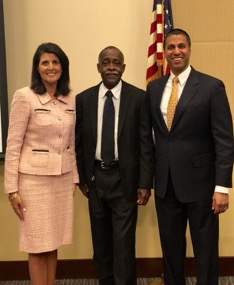
Use of contraband cellphones in prisons. This is the subject of Docket 13-111. Note the first 2 digits are "13" indicating that this NPRM was issued in 2013, actually 3 years ago this week. But this NPRM was in turn based in part on a petition filed by the South Carolina Department of Corrections in July 2009 which was never even put out for public comment. (This explains why the NPRM cryptically refers to the SCDC petition by the mysterious code "PRM09WT" rather than the usual RM number.) But the CTIA-favored approach of "managed access" and continuing the absolute prohibition of any jamming by nonfederal users is basing all progress on a quixotic technology. Meanwhile real people die as a result of crimes ordered by incarcerated criminals. Can't FCC give the cellular industry a date certain to show whether managed access under their preferred approach and conditions is an adequate solution for this life or death issue?
Aviation Tower Marking and Lighting Enforcement: One of the more bizarre statements in the nearly $1M study FCC ordered to justify downsizing field enforcement that has never been formally released (but a leaked version was first made available on this blog) is shown below:
Since tower inspection compliance is good, it can be cut back significantly the consultants reason. But tower lighting and marking issues are different than most other FCC compliance issues like frequency and power regulation. As the Coinjock NC helicopter crash incident dramatically showed major screwup can result in multiple deaths. This different than interference which is typical of most Title III technical violations.
Instrument Landing System (ILS)

FM Pirate Interference to Aircraft Navigation: As we have written previously, the FAA's Instrument Landing System has its "localizer" (left/right determination) signal just above the FM broadcast band. ILS receivers have some sensitivity to interference resulting from overloads of two signals that have a certain relationship to the ILS channel used at a given airport and another local FM station. In normal FM licensing this is considered and the threatening frequency is not allowed near an airport. But illegal FM stations do not go through normal licensing! And if the mathematical relationship with another FM station and the ILS frequency is correct, not much power is needed to create interference if the other FM station has a strong signal near the airport. So downsizing enforcement without leaving an alternative mechanism to address this issue is an invitation to aviation safety issues.
Public Safety Interoperability: The January 13, 1982 Air Florida crash in the Potomac River was the beginning of a national dialogue on public safety interoperability. The 9/11 tragedy was another milestone.
There have been improvements since 1982, but has it really been adequate. Now there are a lot of agencies involved in this area and Congress has had a key role in starting FirstNet. But FirstNet is not going to make a big dent in the basic problem for this is what its website says:
FirstNet will enhance public safety communications by delivering mission-critical data and applications that augment the voice capabilities of today’s land mobile radio (LMR) networksWhen the FirstNet network is initially deployed, it will provide mission-critical, high-speed data services to supplement the voice capabilities of today’s LMR networks.
So while the broadband capabilities of FirstNet will be interoperable, today's land mobile radio networks in a myriad of bands will be around for the foreseeable future and will continue to serve as a Tower of Babel as in 1982. Does FCC even talk about this issue?
Basic Problem
Most FCC decision do not involve safety issues and they are basically "economic regulation" in the terms of my former colleague. Thus FCC is structured to deal with such issues.
The few issues that are really matters of life and death do not easily fit into this framework and theus don't get the attention they deserve. The FCC's inability to resolve the issues in Docket 13-111 is a classic ongoing example of this problem. Will FCC ever give the cellular establishment a firm time limit for implementing their preferred solution or will people just continue to die because of this ongoing problem? There are other solutions besides the quixotic "managed access". FCC has moved heaven and earth to meet cellular industry spectrum demands for 4G and 5G, when will the industry either act to decrease the prison contraband problem or stop blocking other solutions?
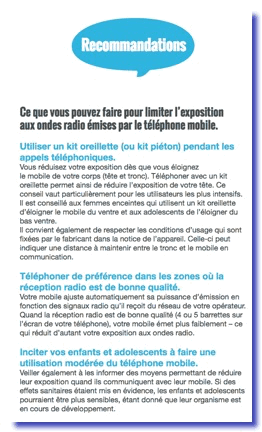
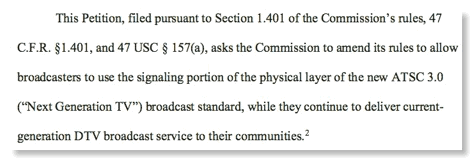



![Validate my RSS feed [Valid RSS]](valid-rss-rogers.png)

